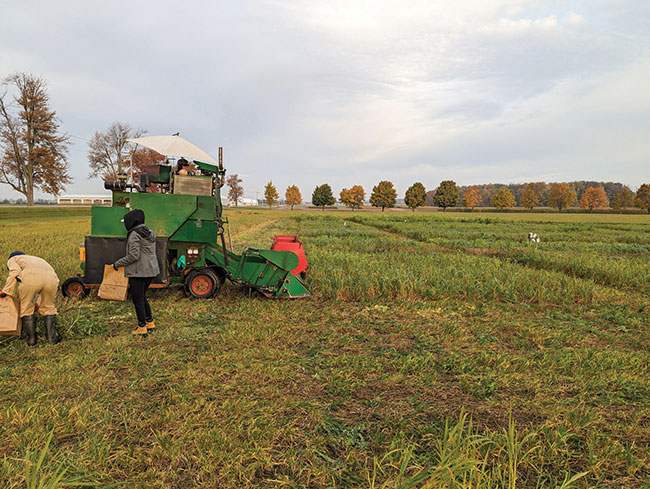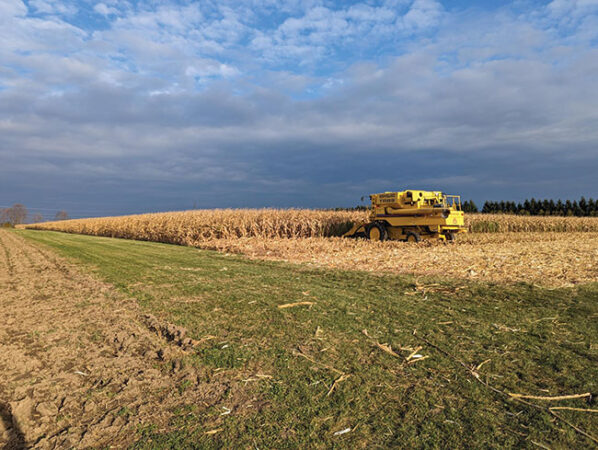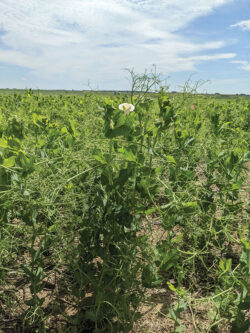
Features
Cover Crops
Legume-based cover crop opportunities
Assessing options to make cover cropping more economically attractive in the short term.
May 6, 2024 By Carolyn King
 The project is assessing the ability of various legume-based cover crops to provide a nitrogen credit to the next year’s corn crop.
Photo courtesy of Connor Goodwin, University of Guelph.
The project is assessing the ability of various legume-based cover crops to provide a nitrogen credit to the next year’s corn crop.
Photo courtesy of Connor Goodwin, University of Guelph. Producers know cover crops can provide an array of benefits, such as improved soil health and decreased disease, insect and weed problems. But in the short term, the costs of buying the seed and planting the cover crop can be a barrier to adoption of this practice. A southern Ontario project is evaluating some legume-based cover crop options to see if they might help overcome this barrier.
“If we can make cover crop use a little more economically feasible in the short term – for example, if the cover crop provides a nitrogen credit to the next crop or if the cover crop is harvested as forage – then cover cropping might be more attractive to farmers,” says Kim Schneider, the project’s principal investigator and an assistant
professor of plant agriculture at the University of Guelph.
This project also reflects Schneider’s research interest in seeking ways to improve nutrient-use efficiency in agriculture. “If we can find places in the rotation to fix more nitrogen biologically using legumes, then we could potentially help decrease nitrogen fertilizer use. And reducing nitrogen fertilizer use would cut down on greenhouse gas emissions associated with nitrogen fertilizers.”
Collaborating with Schneider on this project are her University of Guelph colleagues Elizabeth Lee and John Lauzon. Two master’s students in Schneider’s research group have carried out the project: Daniel Colcuc, who worked on it from 2021 to 2023; and Connor Goodwin, who started in 2023. The Ontario Agri-Food Innovation Alliance and Grain Farmers of Ontario are funding the project.
About the project
This research evaluates several legume-based cover crop options that target the period between harvesting winter wheat and planting corn in a winter wheat-corn-soybean rotation, a common rotation in southwestern Ontario.
“The project has three main objectives. One is to evaluate the ability of annual legume-based cover crops, planted following winter wheat harvest, to provide a nitrogen credit to the next year’s corn crop. We are looking at monoculture legume and mixed-species cover crops, and comparing those to frost-seeded red clover,” explains Schneider.
She says frost-seeding of red clover into a standing winter wheat crop is a fairly common cover crop option in southern Ontario. “Frost-seeding generally involves seeding in early spring when the ground is still frozen but most of the snow has gone. Usually, it is done fairly simply by broadcasting the seed on the surface. Then the seed is kind of worked into the soil through freeze-thaw action. Red clover seems to be one of the species that does fairly well with frost-seeding.”
When red clover does well, Schneider says it can be a great cover crop choice. However, even though red clover does
better than some species with frost-seeding, sometimes it still doesn’t establish very well. And that results in varying levels of benefits in terms of nitrogen (N) credits and aboveground biomass. “Researchers are still figuring out the reasons for this [variability in establishment], but it seems that different environmental conditions may make a difference; for instance, moisture probably plays a role.”
The annual legume-based cover crop options are seeded with a drill in early August just after the winter wheat is harvested. In part, Schneider wants to see if any of these options might provide benefits similar to or better than frost-seeded red clover. “Another reason to look for annual legume alternatives to red clover is to provide more options for farmers. For instance, maybe they weren’t able to get out to frost-seed, or maybe they want to take the cover crop off for forage, and they don’t want all red clover.”
The project’s second objective is to assess the effect of removing the aboveground biomass of the cover crop as if you wanted to harvest it for forage. “We want to see what effect removal has on nitrogen credits and corn crop yields, and whether it makes cover cropping more economical,” she says.
The third objective is to quantify the effect of planting the legumes in a bio-strip – a strip where the corn will be planted in the following year. They want to look at whether concentrating the legumes in a strip would increase the N credit or corn yield. Bio-strips are used by some Ontario farmers as an alternative to strip tillage. In particular, if the bio-strip includes species that have large taproots which can reduce soil compaction and that have residues which break down quickly over the winter, then the bio-strip can provide a fairly nice, relatively bare seedbed in the spring.
The project encompasses three years of cover crops followed by corn, with 2024 being the final corn year. The field site is at the Ontario Crops Research Centre in Elora.

The project is also evaluating removal of the cover crop’s aboveground biomass for forage to see the effect on nitrogen credits, corn yields and cover cropping economics.
Photo courtesy of Connor Goodwin, University of Guelph.
Cover crop options
The trial’s cover crop options include: frost-seeded red clover; berseem clover; balansa clover; Austrian winter pea; oat; radish; oat/radish/berseem clover mixture; oat/radish/balansa clover mixture; oat/radish/Austrian winter pea mixture; and a no-cover-crop control.
Schneider explains, “For the annual legumes, we included pea because it is a fairly common choice. Berseem clover and balansa clover are newer legumes which are less known. We have seen a little bit of success with berseem clover at the research centre in some other trials, and we wanted to see how well these two annual clovers would perform when seeded in August.”
In a mixture with an annual legume, oat and radish can help boost the cover crop’s biomass. Oat is an inexpensive cereal that grows well under a range of conditions. Radish can be a good choice for a bio-strip because its taproot can help in breaking up the soil and the residues decompose quickly after being winterkilled, leaving a bare strip of loose soil for a seedbed for corn.
The trial also compares two options for the cover crops seeded in August: seeding them in a bio-strip; or seeding them uniformly across a plot. If the cover crop was seeded uniformly across the plot, then the plot was strip tilled in both the fall and the spring, to prepare the seedbed for corn planting. Schneider explains, “In the first year there was some extra residue, so we strip-tilled again in the spring. We also did that in the next years to be consistent. However, in most situations, you would probably just need to strip-till in the fall.”
Biomass findings
“We have had three years now of cover crops. The first year, 2021, was definitely our best year for biomass. Red clover was our best performer; it produced about 1.7 tonnes per hectare of aboveground biomass. That was followed by oat and the oat/pea/radish mixture – they each produced about 1.3 tonnes per hectare,” says Goodwin.
“The second year, 2022, was a very dry year, and the red clover didn’t establish at all. But the oat and the oat/pea/radish were still pretty consistent at about 1.3 tonnes per hectare.
“Then in 2023, the conditions were a little moister. The red clover did establish, but it only produced about 1 tonne per hectare. Once again, the oat and the oat/pea/radish were pretty consistent at about 1.3 tonnes.”
The balansa clover and berseem clover did not do very well, especially under dry conditions. “So, out of the annual legumes planted after winter wheat harvest, pea was the most reliable,” notes Schneider.
She adds, “We’re trying to figure out what conditions would help berseem and balansa clovers to do better. For instance, in a separate experiment involving some grazing trials of warm-season forages, berseem was in the mix. When berseem was planted around June 1, you could get three cuts from it. In that system, berseem could be an option. However, when you’re planting in August, the conditions tend to be drier so these clovers won’t do very well; also, you’re getting only one cut.”
N credits, biomass removal, economics
“With red clover, if you can get it to establish, it does very well in terms of the N credit. [In 2021, red clover’s best yielding year,] it provided a benefit of around 70 kilograms of N per hectare for the following corn crop,” says Goodwin.

Austrian winter pea was included in the legume cover crop trials because it is a fairly common option that some growers are already using as a cover crop.
Photo courtesy of Blake Weiseth.
“The monoculture pea was the only other legume that provided an N credit, although not a very large one.” Neither the berseem nor the balansa clover produced enough biomass to result in an N credit in any year.
Planting the legumes in bio-strips did not make a significant difference to the N credits or corn yields compared to planting uniformly across the plots. The cover crop’s biomass yield was greater when planted conventionally than in bio-strips.
Removing the aboveground biomass resulted in a small negative effect on corn yield and a slight reduction in the N credit, but the differences were not agronomically significant.
Goodwin also points out that, despite the reductions in corn yields and N credits,
harvesting the forage was a more cost-effective practice for almost every cover crop choice. “In fact, in 2021, harvesting the red clover’s aboveground biomass was actually about $100 per hectare more profitable than having no cover crop,” he says.
“And the oat and the oat/pea/radish cover crops were pretty close to making cover cropping a net-zero cost when the biomass was harvested.” For instance, in 2021, the cost of the oat cover crop was only about $30 per hectare more than having no cover crop, and in 2022, it was about $70 more.
Interestingly, even without biomass harvesting, the red clover in 2021 was still about $40 per hectare more profitable than having no cover crop. And Goodwin notes the calculations of economic benefits in the project are on the conservative side; for instance, they use custom rates for harvesting rather than assuming that producers would be using their own equipment.
“I’ll be interested to see our corn harvest data from this summer, given that the red clover biomass amount in 2023 was kind of in the middle compared to 2021 and 2022. In 2023, red clover established but it didn’t produce the high biomass we saw in the first year,” he says. “So the 2024 corn yield data might give us a better idea of what a standard year might look like.”
Tips for growers
Based on the results so far, Schneider offers a few tips on cover crop choices: “If you can get red clover to establish, it is probably the best option for providing nitrogen from a legume source.
“If you want to harvest your cover crop for forage and you want to plant it after winter wheat harvest, then monoculture oat or the oat/pea/radish are decent, consistent options. Oat seems to establish relatively well in dry conditions compared to the other species. The oat/pea/radish was a little better than oat in terms of providing a bit of nitrogen and boosting corn yields a little, but it wasn’t a statistically significant difference.
“And if it’s a dry August, don’t put in berseem or balansa clover.”
She emphasizes that this project is looking at short-term profitability – whether the cover crop is economical in that same year or very next season.
“In the short term, it is usually hard for a cover crop to be a lot more profitable than not planting a cover crop,” she says. “Definitely in the long term, there may be economic benefits to the cover crops that we were not able to observe in our study.”
“Any of the treatments in this project that get pretty close to being profitable or that are even more profitable than having no cover crop could be a good option to help people adopt cover cropping in the short term,” says Goodwin.
Schneider adds, “Some of your long-term benefits from cover crops may decrease a bit if you are removing the aboveground biomass. Your choices will depend on how you balance your short- and long-term goals.”